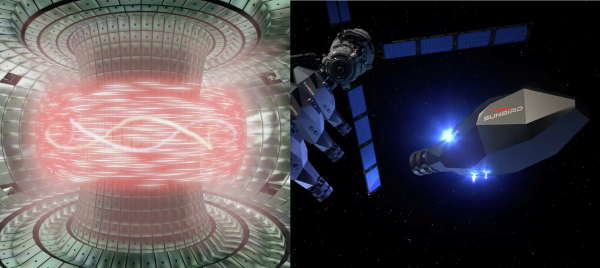Fusion power has always been an over-the-horizon technology, twenty years in the future. But lately, the twenty appears to be shrinking to ten or less.
Recent fusion stories in the news indicate momentum in the pursuit of fusion energy for power production on Earth and fusion engines for rockets to fly to Mars, the rest of the Solar System and beyond.
Progress in Fusion Reactor Technology
Here are some of the fusion reactor stories I have been following:
- In the last few weeks, Canada’s General Fusion, the developer of Magnetized Target Fusion technology, announced the successful creation of a magnetized plasma within its LM26 proof-of-concept reactor. The company has set a goal to reach scientific breakeven by 2027, where it produces more output energy than it consumes. Its UK fusion demonstration reactor, which was to be built near Oxford in the UK, is on hold as General Fusion seeks CDN $150 million in new investment capital. After achieving its breakthrough, it laid off some of its staff to save money. So far, the company has raised CDN$ 440 million with the Canadian government and Jeff Bezos as major investors. Is General Fusion as safe a bet as one can have in the development of commercial fusion? Increasingly, it looks so.
- A Massachusetts Institute of Technology spinoff, Commonwealth Fusion Systems, has developed the SPARC tokamak demonstration reactor. It also plans to demonstrate magnetic fusion technology by 2027, which will lead to building a commercial reactor in Virginia by 2033. So far, Commonwealth has attracted US$ 2 billion with one of its major investors, Microsoft co-founder Bill Gates.
- China has several fusion projects on the go, including the Burning Plasma Experiment Superconducting Tokamak, or BEST, in Hefei, China. Other reactors include the Experimental Advanced Superconducting Tokamak (EAST), in Hefei and the Chinese Fusion Engineering Test Reactor (CFETR), a large-scale fusion power demonstrator. The Chinese media reports that the BEST reactor is scheduled to go online within two years.
- U.S.-based TAE Technologies, Inc. is working with the University of California to develop a new type of fusion technology that it says will produce 100 times the power of other designs while costing half as much to run. Their research was recently published in Nature Communications. The technology design is a Field-Reversed Configuration (FRC) which they have given the name, Norm. TAE claims their fusion reactor design is simpler to build and less costly than the competition.
- U.S.-based Helion Energy just received US$ 425 million in new investment for its pulsed fusion linear reactor technology with direct energy conversion. It bears little resemblance to traditional tokamak fusion reactor designs. The company’s backers include Microsoft, Sam Altman of OpenAI and Peter Thiel. Its operational target is to have a fusion reactor positive energy demonstrator providing energy to Microsoft by 2028 and a commercial operating fusion reactor for the energy industry within a decade.
Other players in recent fusion news include Pacific Fusion, Avalanche Energy, Marvel Fusion and Thea Energy. To learn more about fusion energy reactor developments, go to the Fusion Industry Association’s News website for the latest.
Fusion Energy Propulsion Progress
Investments in fusion energy research are not confined to commercial energy power plants. Fusion-energy-powered rockets could make travel around the Solar System considerably faster than chemical-based systems being used by commercial companies like SpaceX, Blue Origin, the United Launch Alliance, and Rocket Lab.
Today, rocket propulsion for launches is chemical and once in space, builders of spacecraft have adopted ion and Hall-effect thrusters for long-duration, unmanned missions. Nuclear thermal propulsion was first demonstrated in 1959 with the NERVA program from 1961 to 1973 working on a wide range of nuclear-powered rocket engine designs for space missions. None were ever flown in space.
Lately, fusion-powered rocket propulsion engines have made the news. Leading the way is a U.K. startup, Pulsar Fusion, with its Sunbird Migratory Transfer Vehicle. In March 2025, they unveiled their design concept at the Space-Comm Expo in London. Sunbird could make travel times to Mars as short as three months. A trip to Pluto would take four years. New Horizons took almost a decade.
Sunbirds in low-Earth orbit would attach to launched spacecraft and then propel them to Solar System destinations at greater than 500,000 kilometres (329,000 miles) per hour. Only the Parker Solar Probe has travelled faster, aided by the Sun’s enormous gravity.
Sunbirds would use helium-3 in combination with deuterium to obtain fusion. Recently, a company called Interlune won contracts to mine and deliver to Earth helium-3 from the Moon’s surface. No doubt, Pulsar Fusion would be happy to be on the receiving end of some of that largesse since helium-3 is rare on Earth, and mostly harvested in small amounts from decaying tritium in conventional nuclear fission energy plants or directly as a byproduct from Canada’s CANDU heavy-water reactors.
Pulsar hopes to test the first Sunbirds in Earth orbit in 2027.
Joining Pulsar is RocketStar, an American company founded in 2014 that is developing the FireStar Drive, a hybrid electric-fusion propulsion system. FireStar uses a water-fueled pulsed plasma thruster where water vapour is ionized to generate high-speed protons that collide with boron nuclei to cause a fusion reaction. The fusion reaction creates an afterburner effect that can increase thrust performance by 50% over conventional ion and Hall thrusters.
Meanwhile, NASA has been pursuing the development of a fusion-powered rocket. Its experimental Direct Fusion Drive (DFD) would achieve the same results as Pulsar’s Sunbird, providing an onboard propulsion system to reduce Earth-to-Mars transit to 90 days each way with the bonus of providing power to meet the needs of the entire spaceship.
Russia’s space agency, Roscosmos, and the country’s atomic research organization, Rosatom, are also working on an advanced plasma propulsion system, as is the European Space Agency and China’s National Space Administration (CNSA).









